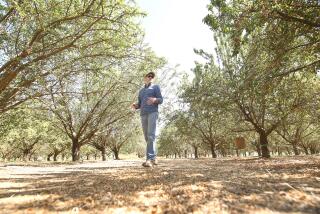Bugged From Down Under
- Share via
VALLEY VILLAGE — Tiny Australian bugs have invaded a grove of stately eucalyptus trees here, and city officials are planning an assault on the insects next week before they can do permanent damage.
The bugs--redgum lerp psyllids--coat their preferred diet of red gum eucalyptus leaves with a hail-like, sticky substance that clings to shoes and creates a mess.
First discovered in El Monte last year, the infestation has quickly spread throughout most of the state, officials said. But the invasion into more than 70 trees at Valley Village Park is the heaviest in the city and will be targeted with the first pilot program to eradicate the insects, said Kevin W. Regan, principal grounds maintenance supervisor for the Los Angeles Department of Recreation and Parks.
“They’re kind of a nuisance more than anything else,” Regan said, “but they probably could kill trees or cause their decline if the infestation is severe enough.”
Millions of the redgum lerp psyllids have coated the leaves of the half-century-old trees. “They are a living, moving, growing and eating thing,” Regan said.
Park foresters next week plan to release more than 2 million ladybugs at Valley Village with the hope that the spotted predators will eradicate the invasion. However, the pest is so new--with California as the first state in the nation to be invaded--that entomologists do not know an effective method of control.
“There’s really nothing we can recommend at this point,” said Ray Gill, biosystematic entomologist with the California Department of Food and Agriculture.
He said scientists plan to study natural predators of the pest in Australia--where both the psyllids and the eucalyptus trees originate--but importation of any natural parasites will take at least a year of quarantine and study before they can be used here.
“Help is on the way. But it will take awhile to go through the process,” Gill said. “We will have to put up with the problem temporarily.”
The pest was first discovered June 17 by a Los Angeles County agricultural inspector in three trees bordering the 10 Freeway near the agricultural commissioner’s office in El Monte, Gill said.
A few weeks later, the insects were found heavily defoliating trees at a park in Alameda County. Next, they showed up at Stanford University in Palo Alto, where students began tracking the sticky residue into classrooms.
The bugs were found in Ontario in October and in Anaheim by December, Gill said. Current reports also place the invasion in San Mateo in the Bay Area, at UC Riverside, earlier this month, at Del Mar in San Diego County, he said.
“We haven’t had any reports of it yet in Ventura or Santa Barbara counties, but it could well be there by now,” Gill added.
He also said there are some indications that the pests are moving beyond just the red gum species to other varieties of eucalyptus, such as the picturesque blue gums along the coast.
“We don’t really know how it’s spreading, whether it is being blown around in the wind or whether the nurseries, for instance, are carting it around,” Gill said. “We just don’t know.”
Regan said it is unknown how the insects got here from Australia, although he said they could have landed on a ship entering the Los Angeles-Long Beach harbor.
Regan said a park landscape supervisor first spotted the insects in trees at Los Angeles Zoo about three months ago and brought him specimens to study. While Regan said he knew the insects were psyllids, “I had never seen that particular type before.” He contacted other experts to positively identify the foreign invader.
“Ever since then, we’ve known what they are,” Regan said, “but we didn’t want to just start taking control measures until we find out what their natural predators are.”
They learned about the infestation at Valley Village Park after a resident, Patricia O’Connell, contacted The Times. O’Connell said she has enjoyed walking through the eucalyptus groves in the park and around her neighborhood for 30 years.
“I noticed all of the trees with eggs on the leaves, just covered all the way up the trees,” O’Connell said. “I hope we don’t lose the trees. They have always been so beautiful.”
Upon inspecting the trees, Regan’s staff also noted that ladybugs appear to be feeding on the pests. “There is some natural biological control going on right now,” Regan said. “We want to protect and preserve our trees, but we don’t like to just use a pesticide because it could also kill beneficial insects.”
Regan said he plans to release about 30 gallons of ladybugs in the park, probably beginning next week. Each gallon container holds about 72,000 ladybugs and costs $65.
Regan said the experiment is more expensive and time-consuming than spraying and “there is no guarantee it will work” because the young pests are covered with a protective coating.
He also warned, “Ladybugs have a mind of their own. They may not stick around.” However, he said the pilot project is bound to benefit gardeners in the neighborhood.
If the program is found successful within the next 30 to 45 days, similar steps may be taken in other parks, Regan said.
As a backup plan, the city also is considering using a pesticide that is injected directly into the tree and acts as a systemic.
“It would be really tragic to lose these beautiful trees that provide so much benefit and shade to the community,” Regan said.
Meantime, officials with the city’s Department of Public Works said they have not been notified of any attacks by the new agricultural pest on street trees. Residents who spot a problem with city-owned eucalyptus trees can report to a hotline: (800) 996-2489.
More to Read
Sign up for Essential California
The most important California stories and recommendations in your inbox every morning.
You may occasionally receive promotional content from the Los Angeles Times.










